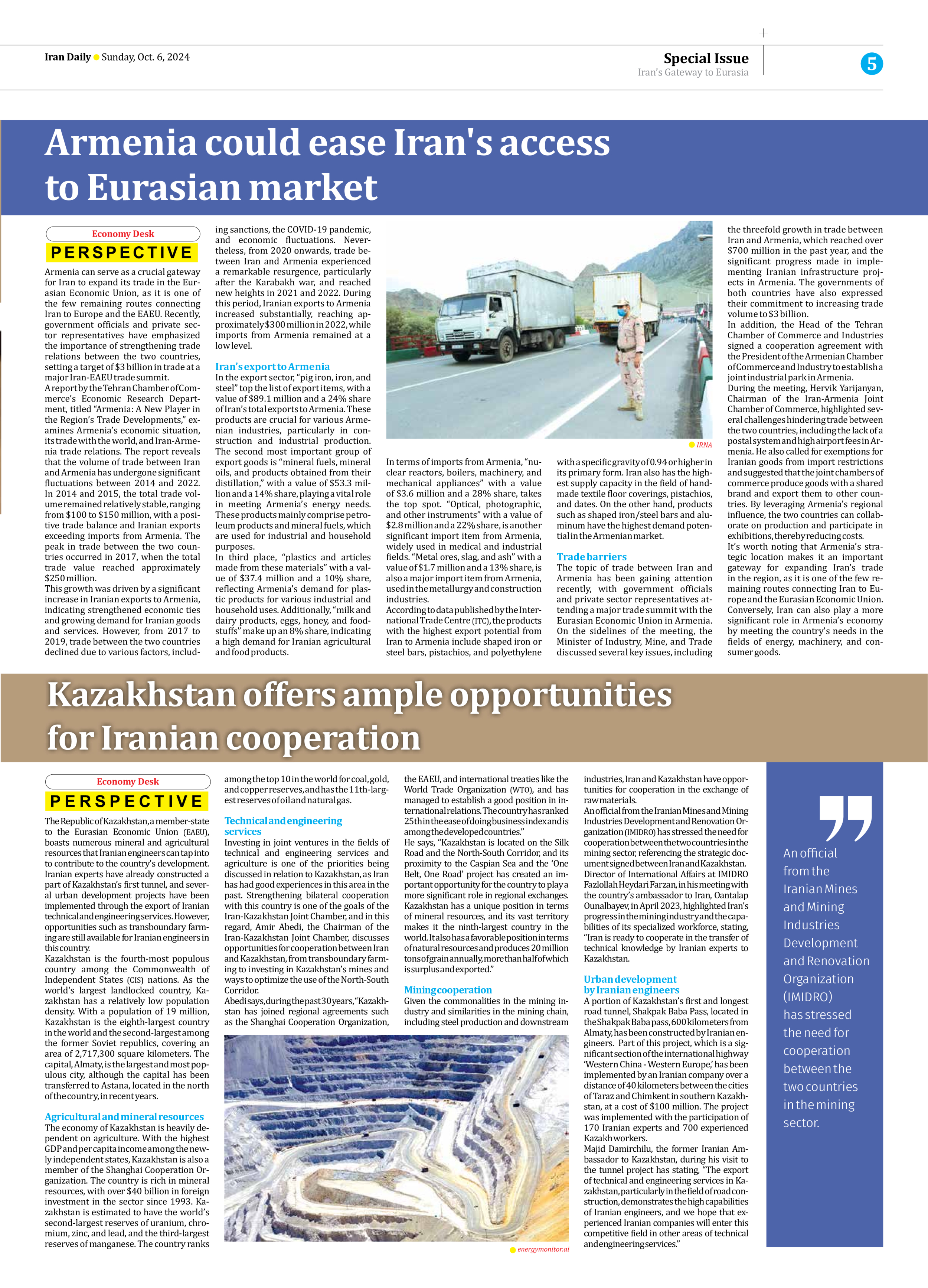
Armenia could ease Iran’s access to Eurasian market
Armenia can serve as a crucial gateway for Iran to expand its trade in the Eurasian Economic Union, as it is one of the few remaining routes connecting Iran to Europe and the EAEU. Recently, government officials and private sector representatives have emphasized the importance of strengthening trade relations between the two countries, setting a target of $3 billion in trade at a major Iran-EAEU trade summit.
A report by the Tehran Chamber of Commerce’s Economic Research Department, titled “Armenia: A New Player in the Region’s Trade Developments,” examines Armenia’s economic situation, its trade with the world, and Iran-Armenia trade relations. The report reveals that the volume of trade between Iran and Armenia has undergone significant fluctuations between 2014 and 2022. In 2014 and 2015, the total trade volume remained relatively stable, ranging from $100 to $150 million, with a positive trade balance and Iranian exports exceeding imports from Armenia. The peak in trade between the two countries occurred in 2017, when the total trade value reached approximately $250 million.
This growth was driven by a significant increase in Iranian exports to Armenia, indicating strengthened economic ties and growing demand for Iranian goods and services. However, from 2017 to 2019, trade between the two countries declined due to various factors, including sanctions, the COVID-19 pandemic, and economic fluctuations. Nevertheless, from 2020 onwards, trade between Iran and Armenia experienced a remarkable resurgence, particularly after the Karabakh war, and reached new heights in 2021 and 2022. During this period, Iranian exports to Armenia increased substantially, reaching approximately $300 million in 2022, while imports from Armenia remained at a low level.
Iran’s export to Armenia
In the export sector, “pig iron, iron, and steel” top the list of export items, with a value of $89.1 million and a 24% share of Iran’s total exports to Armenia. These products are crucial for various Armenian industries, particularly in construction and industrial production. The second most important group of export goods is “mineral fuels, mineral oils, and products obtained from their distillation,” with a value of $53.3 million and a 14% share, playing a vital role in meeting Armenia’s energy needs. These products mainly comprise petroleum products and mineral fuels, which are used for industrial and household purposes.
In third place, “plastics and articles made from these materials” with a value of $37.4 million and a 10% share, reflecting Armenia’s demand for plastic products for various industrial and household uses. Additionally, “milk and dairy products, eggs, honey, and foodstuffs” make up an 8% share, indicating a high demand for Iranian agricultural and food products.
In terms of imports from Armenia, “nuclear reactors, boilers, machinery, and mechanical appliances” with a value of $3.6 million and a 28% share, takes the top spot. “Optical, photographic, and other instruments” with a value of $2.8 million and a 22% share, is another significant import item from Armenia, widely used in medical and industrial fields. “Metal ores, slag, and ash” with a value of $1.7 million and a 13% share, is also a major import item from Armenia, used in the metallurgy and construction industries.
According to data published by the International Trade Centre (ITC), the products with the highest export potential from Iran to Armenia include shaped iron or steel bars, pistachios, and polyethylene with a specific gravity of 0.94 or higher in its primary form. Iran also has the highest supply capacity in the field of handmade textile floor coverings, pistachios, and dates. On the other hand, products such as shaped iron/steel bars and aluminum have the highest demand potential in the Armenian market.
Trade barriers
The topic of trade between Iran and Armenia has been gaining attention recently, with government officials and private sector representatives attending a major trade summit with the Eurasian Economic Union in Armenia. On the sidelines of the meeting, the Minister of Industry, Mine, and Trade discussed several key issues, including the threefold growth in trade between Iran and Armenia, which reached over $700 million in the past year, and the significant progress made in implementing Iranian infrastructure projects in Armenia. The governments of both countries have also expressed their commitment to increasing trade volume to $3 billion.
In addition, the Head of the Tehran Chamber of Commerce and Industries signed a cooperation agreement with the President of the Armenian Chamber of Commerce and Industry to establish a joint industrial park in Armenia.
During the meeting, Hervik Yarijanyan, Chairman of the Iran-Armenia Joint Chamber of Commerce, highlighted several challenges hindering trade between the two countries, including the lack of a postal system and high airport fees in Armenia. He also called for exemptions for Iranian goods from import restrictions and suggested that the joint chambers of commerce produce goods with a shared brand and export them to other countries. By leveraging Armenia’s regional influence, the two countries can collaborate on production and participate in exhibitions, thereby reducing costs.
It’s worth noting that Armenia’s strategic location makes it an important gateway for expanding Iran’s trade in the region, as it is one of the few remaining routes connecting Iran to Europe and the Eurasian Economic Union. Conversely, Iran can also play a more significant role in Armenia’s economy by meeting the country’s needs in the fields of energy, machinery, and consumer goods.







